- Visibility 1.1k Views
- Downloads 73 Downloads
- Permissions
- DOI 10.18231/j.ijodr.2024.025
-
CrossMark
- Citation
Anterior open bite correction in adults through MEAW technique: A case report
- Author Details:
-
Anfiya Nazeer *
-
Sam Paul
-
Prince Chacko
-
Varun Peter
Abstract
Anterior open bite malocclusion presents a challenging issue in orthodontic treatment. This difficulty arises from the distinct occlusal planes of the maxillary and mandibular dentitions. Unlike the overlap observed in normal occlusion, the open bite is characterized by the anterior divergence of these planes. This is a case report of a 25-year-old female patient with an anterior open bite successfully treated with the MEAW technique. There is an overall improvement in the patient's facial profile and occlusion post-treatment.
Introduction
Open bite is defined as a lack of vertical overlap between opposing teeth when the remaining teeth are in maximum intercuspation.[1] The open bite may manifest in the anterior or posterior dentition. Three main etiological factors causing an anterior open bite are non-nutritive sucking or chewing, such as on a digit, pacifier, or pen; abnormal tongue size and function, including posturing and thrusting; and a hyperdivergent maxillo-mandibular growth pattern.[2] Other less common contributing factors may include condylar resorption, total nasal obstruction, and muscle weakness (muscular dystrophy).[3] Anterior open bite is multifactorial in nature, and there is a great diagnostic challenge in determining which of these factors contribute to the anterior open bite for a particular patient.
A 1973 survey of 7,400 American children between the ages of 6 and 11 found a prevalence of anterior open bites in 4% of Caucasians and 16% in African Americans.[4] More recent publications estimate the prevalence of anterior open bite as 18.84% in the primary dentition and 14.26% in the mixed dentition.[5] Since anterior open bite is widely considered one of the most challenging malocclusions to treat, it is imperative that all orthodontists not only understand the etiology and prevention of anterior open bite but also options for its correction.
In 1987, Dr. Y H Kim declared that with an understanding of the origins of open bites and the dynamics of orthodontic mechanotherapy, anterior open bites could be treated with a high degree of success and stability without surgical intervention.[6] Dr. Kim introduced the Multiloop Edgewise Arch wire (MEAW) technique, using specialized wires and mechanics with a standard edgewise appliance system. The reported mechanisms of the MEAW technique involve the distal uprighting of posterior teeth, as well as the extrusion and uprighting of the incisors. These actions result in the convergence of the occlusal planes, effectively closing the anterior open bite.[7]
This article presents a case report of a 26-year-old female patient with open bite malocclusion treated using the MEAW technique.
Case Report
A 26-year-old woman presented at the Department of Orthodontics and Dentofacial Orthopedics, citing her primary concern as the spacing between her upper and lower front teeth. The patient expressed a preference for orthodontic treatment for aesthetic reasons. Furthermore, neither the patient's siblings nor parents exhibited similar malocclusion, indicating that there was no hereditary factor contributing to the patient's condition.
Upon clinical examination, the patient had a mesoprosopic facial form, mesocephalic head shape with a convex facial profile, straight divergence with an average clinical FMA, right-angled nasolabial angle, average mentolabial sulcus, and a normal chin. No gross facial asymmetry was noted ([Figure 1]). The patient had a tongue-thrusting habit, which was diagnosed by placing a small amount of water in the mouth and parting the lips slightly while swallowing to observe the tongue. The tongue moved forcefully forward when water was swallowed.
The patient exhibited a class I molar and canine relation on the left side, and a class III molar and canine relation on the right side. Additionally, the patient had an anterior open bite and a negative overjet of -1 mm. A papillary-penetrating upper frenum present ([Figure 2]).
Cephalometric evaluation revealed a class I jaw base (ANB: 4.0) with orthognathic maxilla and mandible, and an average growth pattern (SN-GoGn: 35°). Both upper and lower incisors were proclined. On panoramic radiograph, all teeth were present with root closure ([Figure 3]).
The patient was diagnosed with Angle’s class I malocclusion, on a class I skeletal base, bimaxillary proclination, spaced upper and lower anteriors, anterior open bite, and rotations in relation to teeth 23, 15, 33, 31, 35, and 37, with an average growth pattern and a tongue-thrusting habit.
Treatment objectives
To correct the anterior open bite
To achieve normal incisor axial inclination
To maintain Class I molar, canine and incisor relation
To attain optimal alignment of the upper and lower teeth
To achieve ideal overjet and overbite
Treatment plan
Based on the clinical examination and cephalometric evaluation showing anterior open bite malocclusion, we decided to treat this case using the Multiloop Edgewise Archwire (MEAW) technique. Non-extraction treatment was planned for the patient. In order to correct the tongue-thrusting habit, a fixed tongue crib was recommended. The patient was advised to perform tongue exercises by placing an orthodontic rubber band on the tip of the tongue and occluding it by pressing against the palate to correct the tongue-thrusting habit.
Treatment progress
A straight-wire orthodontic fixed appliance using the MBT prescription on slot size 0.022*0.028 inches (3M Unitek Gemini Metal Twin Brackets) was bonded in both the maxillary and mandibular arches (Figure 4). A fixed tongue crib was cemented in the upper arch. Leveling began with 0.014-inch nickel-titanium (NiTi) and 0.016-inch NiTi wires, followed by 0.016*0.022, 0.017*0.025, and 0.019*0.025 NiTi wires, and finally, 0.019*0.025-inch stainless steel wires. After initial alignment, space closure commenced with power chains in the upper arch. Since the mandibular tooth material was in excess by 2.17mm in the Bolton analysis, proximal reduction was performed in the lower anterior region.
To correct the open bite, a Multiloop Edgewise Archwire (MEAW) was constructed. A 0.018 AJ Wilcock archwire, with boot loops in all interproximal areas from the lateral incisors to the first molars was utilized (Figure 5). Bilateral symmetry and vertical segment angulations checked on each loop to prevent gingival injuries. Tip-back bends incorporated, and the curve of Spee in the maxillary arch was increased. Simultaneously, a lower 0.017*0.025 stainless steel reverse curve wire placed with crimpable hooks. The tip-back bends and Spee curves applied intrusive forces to the maxillary and mandibular incisors. Subsequently, the patient was instructed to wear red elastics (3/16 inch, 6oz) full-time except while eating and brushing. On closed mouth these elastics exerted a force of 50 g and 150 g on moderate mouth opening. Follow-up appointments were on every 2 weeks. The anterior open bite was corrected within 3 months using the MEAW technique.
After bite closure and finishing, the treatment objectives were achieved, and the appliances were removed ([Figure 6], [Figure 7]). Following full debanding and debonding, Hawley retainers were delivered for retention. As the patient diligently practiced tongue exercises, the response was positive, and upon closure of the bite, the habit of tongue thrusting ceased. This indicated that the patient exhibited a secondary type of tongue thrusting. Thus, a tongue crib was not included during retention period. The patient was instructed to wear the retainers 24 hours per day for 6 months, except while eating or brushing, and then only at nighttime afterward. On patient's request, fixed retainers were not bonded.
Treatment results
The intraoral photographs showed satisfactory dental alignment, Class I canine and molar relationships, ideal overjet and overbite, and coincident midlines. The radiographic examination ([Figure 8]) demonstrated satisfactory root parallelism.
Upon comparing the cephalometric values after treatment, the mandibular plane angle increased from 35° to 39°. Similarly, 2° clockwise rotation was evident in palatal plane and occlusal plane. Upper and lower incisors proclination decreased, and the interincisal angle increased to 116°.
The patient expressed satisfaction with her smile and facial appearance. The final photographs exhibit commendable lip competence, correction of the open bite, and enhancement of the facial profile ([Figure 6]). Tooth intercuspation was adequate. A decreased projection of the lips shown by the Ricketts E-line and an increased nasolabial angle observed after treatment.
|
Parameter |
Pre treatment |
Post treatment |
|
SNA |
82 |
82 |
|
SNB |
78 |
78 |
|
ANB |
4 |
4 |
|
SN to GO-GN |
35 |
39 |
|
SN to Occlusal plane |
17 |
19 |
|
SN to palatal plane |
10 |
12 |
|
Upper incisor NA (angular) |
38 |
33 |
|
Upper incisor NA (linear) |
10 mm |
7 mm |
|
Lower Incisor to NB (angular) |
38 |
28 |
|
Lower Incisor to NB(Linear) |
10mm |
8mm |
|
Interincisal angle |
102 |
116 |
|
IMPA |
99 |
89 |
|
Saddle angle |
112 |
120 |
|
Articular angle |
149 |
145 |
|
Anterior-Post facial height ratio |
63.1 |
64.1 |
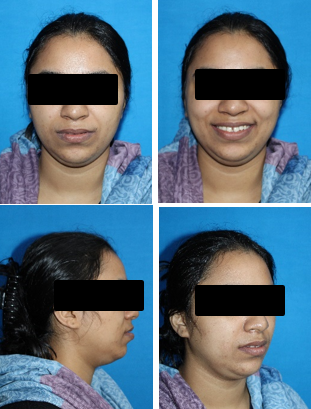
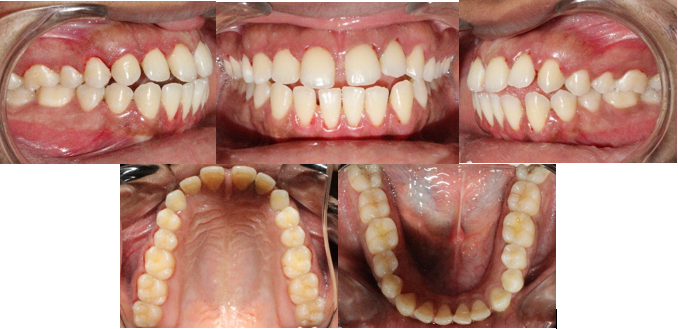
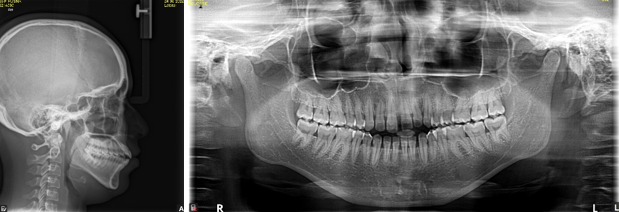
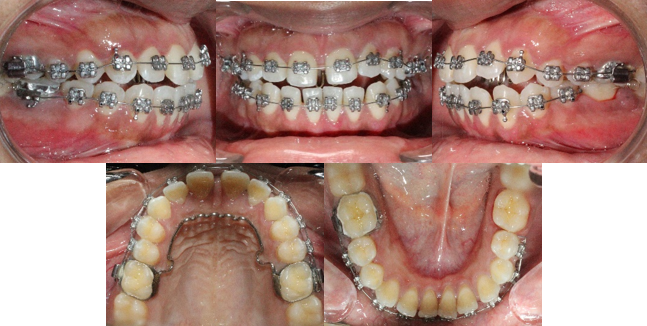

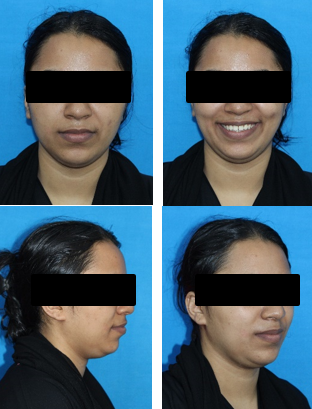
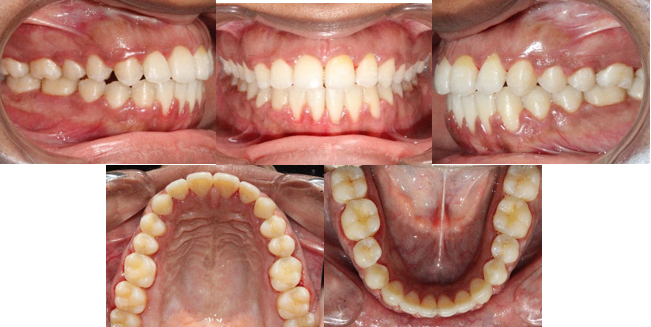
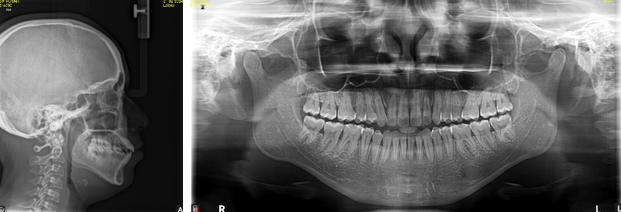
Discussion
Orthodontic treatment for patients with skeletal open bite typically involves intruding the posterior teeth or halting their continued eruption to regulate anterior facial height. Various methods in the literature utilize orthopaedic and orthodontic forces. [8], [9] Both the teeth and the alveolar process significantly influence the vertical positioning of the dentition as they adapt to the relationship of the jaws, allowing for the correction of overbite and overjet through orthodontic adjustments alone. [10]
Mild to severe cases of anterior open bite can be effectively treated and maintained following MEAW (Multiloop Edgewise Archwire) therapy. In open bite treatment, it's essential to correct the cant of occlusal planes to ensure stability and functionality. The biomechanical system offered by the multiloop edgewise archwire facilitates achieving these stated objectives. [11]
MEAW contains two types of loop components, vertical and horizontal. The configuration of individual loops is L-shaped. The vertical loop segment serves as a break between the teeth, lowers the load deflection rate, and provides horizontal control. The horizontal loop further reduces the load deflection rate and provides vertical control. The vertical height of the loop is 2-3 mm, and the horizontal segment is 5 mm for first mesial loop, gradually increasing posteriorly.
In actual MEAW technique proposed by Kim, rectangular stainless steel wire in edgewise brackets were recommended. But here we used round stainlesssteel wire in preadjusted edgewise brackets. Even though no torque loss was evident at the end of treatment.
Simple extrusion of anterior teeth to correct open bite has been criticized as being unstable. Ellis and McNamara [12] even reported that the vertical heights of the anterior maxilla were already increased in open bite cases. Chang and Moon [13] provided evidence that treatment changes with MEAW were similar to natural dentoalveolar compensatory mechanisms. Denison et al. reported that the increase in facial height did not always produce a concomitant decrease in incisal overbite. [14] The eruption of the upper incisors, as a compensatory mechanism, maintained the overbite despite the increase in facial height.
The MEAW technique offers notable therapeutic benefits and serves as a compensatory treatment approach for various types of malocclusion. Its mechanical characteristics makes it well-suited for treating different malocclusions, providing the ability to manage each tooth individually with gentle, consistent forces. Complex cases such as open bite or skeletal class III malocclusions with low to moderate severity can be effectively addressed using this method. [15]
MEAW therapy has proven to be effective in treating anterior open-bite malocclusion, as demonstrated by Kim et al. [7] They found no significant relapse in a 2-year follow-up study, indicating long-term stability. This technique is capable of retracting and extruding anterior teeth while uprighting the posterior teeth.[2], [7] It stands as a viable option for orthodontic treatment of skeletal open bite, although its impact on skeletal patterns is limited. There is still debate regarding its ability to intrude posterior teeth, with limited studies exploring the effects of MEAW on the dentition. However, it's worth noting that the MEAW approach demands high professional skill and relies heavily on patient compliance for successful treatment outcomes.
Conclusion
The MEAW appliance has demonstrated excellent treatment outcomes, successfully achieving the intended goals. However, it necessitates a high level of professional expertise. This technique plays a crucial role in completing and refining the closure of open bites and in uprighting teeth.
Declaration of Patient Consent
The author confirms that all necessary patient consent forms have been obtained. The patient has provided consent for the use of their images and clinical information in the journal. It has been made clear to the patient that their name and initials will not be published, and every effort will be made to maintain their anonymity.
Source of Funding
The author received no financial support for the research, authorship, and/or publication of this article.
Conflicting of Interests
The author declared no potential conflicts of interest with respect to the research, authorship, and/or publication of this article.
References
- Subtelny JD, Sakuda M. Open-bite: Diagnosis and treatment. Am J Orthod. 1964;50(5):337-58. [Google Scholar]
- Beane R. Nonsurgical management of the anterior open bite: a review of the options. Semin Orthod. 1999;5(4):275-83. [Google Scholar]
- Todoki L, Finkleman S, Funkhouser E. The National Dental Practice-Based Research Network Adult Anterior Open Bite Study: Treatment success. Am J Orthod Dentofacial Orthop. 2020;158(6):137-50. [Google Scholar]
- Kelly J, Sanchez M, Kirk LV. An Assessment of the Occlusion of the Teeth of Children 6-11Years, United States. Vital Health Stat 11. 1973. [Google Scholar]
- Avrella M, Zimmermann D, Andriani J, Santos P, Barasuol J. Prevalence of anterior open bite in children and adolescents: a systematic review and meta-analysis. Eur Arch Paediatr Dent. 2022;23(3):355-64. [Google Scholar]
- Kim Y. Anterior openbite and its treatment with multiloop edgewise archwire. Angle Orthod. 1987;57(4):290-321. [Google Scholar]
- Kim Y, Han U, Lim D, Serraon M. Stability of anterior openbite correction with multiloop edgewise archwire therapy: A cephalometric follow-up study. Am J Orthod Dentofacial Orthop. 2000;118(1):43-54. [Google Scholar]
- Sabri R. Nonsurgical correction of a skeletal Class II, Division 1, malocclusion with bilateral crossbite and anterior open bite. Am J Orthod Dentofacial Orthop. 1998;114(2):189-94. [Google Scholar]
- Lopez-Gavito G, Wallen T, Little R, Joondeph D. Anterior open-bite malocclusion: a longitudinal 10-year postretention evaluation of orthodontically treated patients. Am J Orthod. 1985;87(3):175-86. [Google Scholar]
- Kim Y, Han U, Lim D, Serraon M. Stability of anterior openbite correction with multiloop edgewise archwire therapy: a cephalometric follow-up study. Am J Orthod Dentofacial Orthop. 2000;118(1):43-54. [Google Scholar]
- Kim Y. Anterior openbite malocclusion: nature, diagnosis and treatment by means of multiloop edgewise archwire technique. Angle Orthod. 1987;57(4):290-321. [Google Scholar]
- Ellis E, Mcnamara J. Components of adult Class III open-bite malocclusion. Am J Orthod. 1984;86(4):277-90. [Google Scholar]
- Chang Y, Moon S. Cephalometric evaluation of the anterior openbite treatment. Am J Orthod Dentofacial Orthop. 1999;115(1):29-38. [Google Scholar]
- Denison T, Kokich V, Shapiro P. Stability of maxillary surgery in openbite versus non-openbite malocclusions. Angle Orthod. 1989;59(1):5-10. [Google Scholar]
- Marañón-Vásquez G, Galarza LS, Solis FT, Wilson C, Romano F. Aesthetic and functional outcomes using a multiloop edgewise archwire for camouflage orthodontic treatment of a severe Class III open bite malocclusion. J Orthod. 2017;3(3):199-208. [Google Scholar]
How to Cite This Article
Vancouver
Nazeer A, Paul S, Chacko P, Peter V. Anterior open bite correction in adults through MEAW technique: A case report [Internet]. IP Indian J Orthod Dentofacial Res. 2024 [cited 2025 Nov 05];10(2):133-137. Available from: https://doi.org/10.18231/j.ijodr.2024.025
APA
Nazeer, A., Paul, S., Chacko, P., Peter, V. (2024). Anterior open bite correction in adults through MEAW technique: A case report. IP Indian J Orthod Dentofacial Res, 10(2), 133-137. https://doi.org/10.18231/j.ijodr.2024.025
MLA
Nazeer, Anfiya, Paul, Sam, Chacko, Prince, Peter, Varun. "Anterior open bite correction in adults through MEAW technique: A case report." IP Indian J Orthod Dentofacial Res, vol. 10, no. 2, 2024, pp. 133-137. https://doi.org/10.18231/j.ijodr.2024.025
Chicago
Nazeer, A., Paul, S., Chacko, P., Peter, V.. "Anterior open bite correction in adults through MEAW technique: A case report." IP Indian J Orthod Dentofacial Res 10, no. 2 (2024): 133-137. https://doi.org/10.18231/j.ijodr.2024.025
